“Ideas en tránsito. No – construidos”, una exposición de Enrique Norten | TEN arquitectos en el Museo Franz Mayer
En el marco de su más reciente exposición en el Museo Franz Mayer de la Ciudad de México, Enrique Norten [...]

24 marzo, 2025
por Alejandro Hernández Gálvez | Twitter: otrootroblog | Instagram: otrootroblog
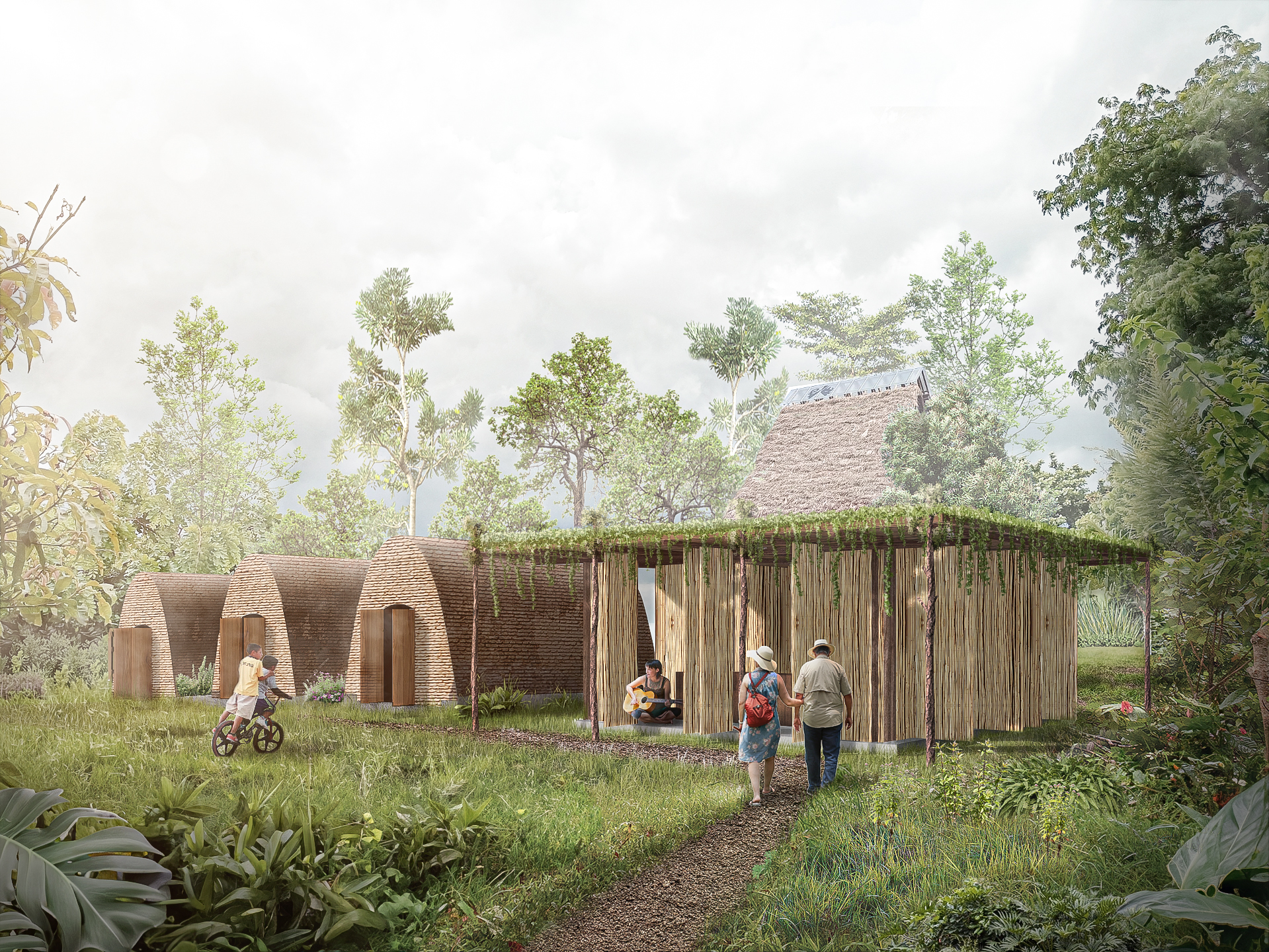
Amazonian Eco-Harvest Hub. Al Borde. Huaticocha, Ecuador. Cortesía: re:arc institute Practice Lab
The scale needs to be balanced. Negative contributions to climate change in architecture remain larger than the projects that aim to counter it. Fundings are scarce, decision-making is slow and damage control becomes unsustainable. As much as 42 percent of carbon emissions come from the construction industry, investments in projects to improve the built environment from the philanthropy sector remain rachitical in comparison. The following conversation between Nicolay Boyadjiev, Alejandro Hernández Gálvez and Pablo Goldin addresses possible relations and conflicts between the Philanthropy and Architecture industries in the context of the recent activities of re:arc institute’s Practice Lab working to support local architects and communities through site-specific projects across the globe.
Parallels: Alternative paths in architecture
Alejandro Hernández Gálvez: In previous conversations, we discussed the need for artists, architects, and many other professions to do what they are supposed to and the different impediments that this “obvious” but not common condition in the predominant labor systems. How do you arrive at this idea of a “parallel system” to the existing ones?
Nicolay Boyadjiev: The key word is parallel. I think many arguments in this space are exactly that: arguments, framed as “A versus B”, “good versus bad”, “this over that”’ etc. This is perhaps an inherited intellectual or disciplinary habit, to advocate “against” or “in opposition” to a seemingly given or de facto condition which must be rejected wholesale for something else and “better” to appear… In the world of architecture, speaking from direct personal and professional experience, I could certainly think of situations in which such rhetoric is applicable, not at all because it accurately reflects reality but simply because it “works”… But I don’t believe this to be the right framing for our work. I often use “para” instead of “anti”, “better”, etc. because the Practice Lab experiments with parallel models of commission missing within the industry: alternative funding conduits to enact change and transform the built environment otherwise. We’re interested in alternatives to traditional philanthropy in architecture rather than perpetuating the perception of this work as “charity” or the “rewarding” of past achievements. Simply put, our work is about creating and exploring an alternative space of possibility for architectural production, currently unaddressed.
Trojan horse: Architectural creativity and resistance
AHG: I can’t avoid thinking about the possible conflicts between philanthropy and the industries that support it. Younger generations of my students, for example, react to the clothing industry by rejecting things that don’t follow their values and questioning them. Would you describe the relationship with the philanthropy industry in architecture as a sort of Aikido to use the strength of large corporations that fund it to do something else?
NB: Perhaps, but not entirely. As a student or working as a young designer within various large corporate architectural firms over 10 years ago, I was definitely inspired by a comparably lateral, strategic approach, well described in an influential book at that time titled “Dark Matter and Trojan Horses” published by the Strelka Institute in Moscow which I would eventually join. Aikido could metaphorically be interpreted as a useful guiding principle for what design could be, especially if you don’t have the upper hand. However I believe it still implies an adversarial relationship, an “opponent” which could unwillingly be “subdued” to our so-called wit or made compliant into a role they weren’t willing to play in the first place. While appealing in theory because it elevates the supposed power of design, unfortunately, in practice I have found this perspective to grossly overestimate the actual leverage and strategic acumen of designers, and grossly underestimate the actual contextual awareness and intelligence of their patrons.
Through re:arc institute’s Practice Lab, we’ve interpreted the intersection between philanthropy and architecture as a potential opportunity space hiding in plain sight, and rather that slyly attempting to manoeuvre our way through either of these industries at face value, we hope to clearly articulate an alternative “common sense” for more thoughtful overlaps across both sectors beyond the simple proliferation of award galas, temporary pavilions, or other symbolic or performative gestures.
AHG: So how did you manage to build a parallel system that works for both worlds?
NB: It’s an interesting question because our stakeholders so to speak are very different from traditional “clients” in architecture, and this in both directions. Both our supporters and advisers at the Inter IKEA Foundation, as well as the professional practitioners and local communities with which we collaborate with on the ground, understand the non-commercial character of the projects that we wish to support, thus liberating the outcomes from the pressures of “ROI” (Return of Investment) in conventional market terms. But interestingly, both also understand the activities that we fund as “work” — quite literally — or labor rather than charity, which is a crucial unifying thread across both worlds. It’s ultimately important to recognise architecture, independent of all of its poetic, mellifluous, self-aggrandising metaphors of “frozen music” or “liquid stone” etc., as fundamentally a type of work as in its literal sense of “force x displacement”: the herculean effort required in the deliberate mobilisation of resources, capital, materials, energy etc. to transform the built environment according to social guidelines that are hopefully meaningful, responsible, and viable in all directions… I think architecture’s non-profit sector ought to possibly interpret its role and impact in similar terms: the search for more inclusive, egalitarian, inventive ways to enable site-specific work that is needed, but for which there are no traditional state or market incentives or traditional “clients” to commission it…
To answer your question perhaps in more direct and pragmatic terms, it becomes interesting to overlap both industries — architecture and philanthropy — and test how they can, cannot, and could transform one another. What alternative funding mechanisms could support the “under-realised” within philanthropy (i.e. “what we should do more of”), but also the “unrealised” and even currently “unrealisable” within architecture (i.e. not only “what we don’t do”, but “what we can’t do” under current existing paradigms)? The Practice Lab is rearc’s space of learning by doing, where we explore these poles, support the realisation of built architectural projects in local contexts, and therefore in the process strive to prototype new contractual relationships and legal pipelines to transparently channel “non-profit” funding to “non-non-profit” architectural studios and professional practitioners realising meaningful work that would otherwise go unrealised because often unrealisable under current structures.
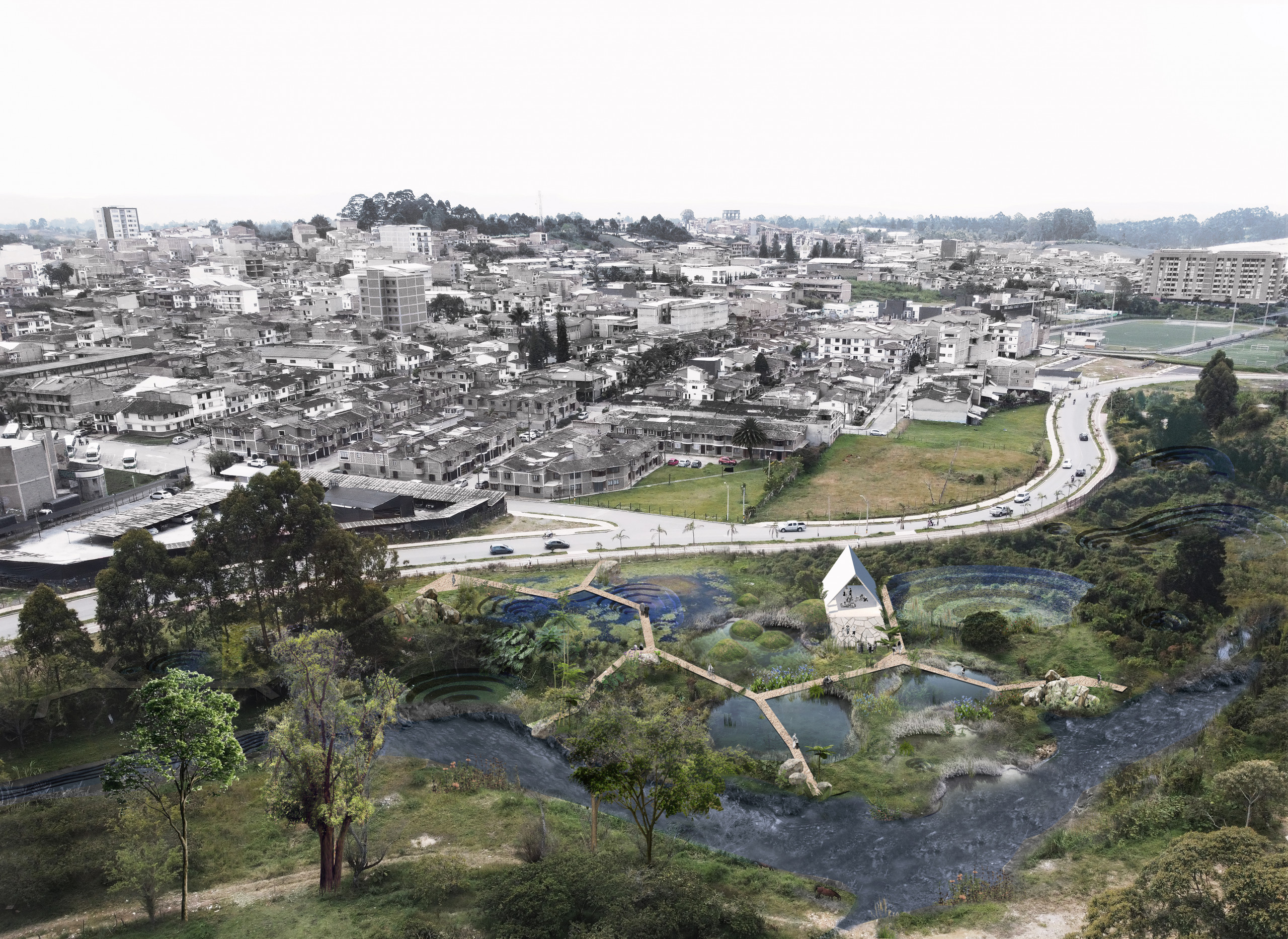
Botanical Garden for Aquatic Collections. Connatural. El Carmen de Viboral, Colombia. Cortesía: re:arc institute Practice Lab
Leviathan: Designing legal frameworks for philanthropic architecture projects.
AHG: Thinking about the legal system that you work with. There has been a lot of theory about how norms and laws make buildings and cities possible to be as they are. As architects, how do you work in that field?
NB: Yes — and similarly, I’m struck by the fact that there has also been a lot of theory on “platform design” in architecture, given how various tech platforms have popularised this term over the last decade and made it something that we think about in the context of urban design. There is much to say on this topic which would warrant a much longer conversation, but what I think is useful for design in this context is an understanding and appreciation of the notion of restrictive while generative path dependency; how any change or transformation is enabled and therefore constrained by the many “tracks” that have been laid by a platform in advance. The legal systems we have similarly act as entrenched yet generative platforms, allowing some things to happen while others not. And coming back to architecture, I think the biggest challenge of our century will be the deliberate and effective transformation of such protocols of space-making which give shape to our built environment.
If you think about both the legal system and to some extent the construction industry as a whole as platforms, the design project ahead of us will require enabling alternative relationships between site, “clients”, communities of users and professional practitioners, formalised by alternative legal pipelines and frameworks for distributing resources and decision-making in accountable ways, resulting in more socially and ecologically responsible built structures. Our part of this project focuses on a specific niche of this problem, at the intersection of philanthropy in architecture, but nevertheless, this is the actual design project that I think 21st century designers and architects ought to focus on well beyond the proliferation of standalone signature buildings or “masterpieces”. Obviously, these are my own personal beliefs at least as much as they are reflective of the lab’s overall agenda, but my general point is that this is a locus of activity that has first to be recognised and identified in order to be taken more seriously as a design discipline, with its own creative or “aesthetic” pleasures.
Shades of colonialism / The best of both worlds: Nonprofit work in developing countries.
AHG: Currently, I try to think in these terms more often than before, “imperialism”, “colonialism”, and all of that, that we are dealing with, in everything possible. I would like to better understand these legal dialogues between Latin American legal and banking systems for example and the Danish ones. How do you conciliate possible frictions or misunderstandings and how do you avoid possible colonialism shadows in the process? How does the organization value different practices and evaluate the authenticity of projects in different contexts?
NB: We acknowledge the challenge of setting up a nonprofit in Denmark while working in a range of very diverse geographies. I think being officially based in Copenhagen has enabled us first and foremost to build a stable, robust, responsible contemporary operating model for grant-making, which embodies the flexibility and trust-based values underlying our mission. Copenhagen is also a fantastic context for our creative legal design experiments — in collaboration with our pro-bono legal advisors Kromann Reumert — where we learn from and adapt the existing philanthropic legal frameworks I was mentioning.
At the same time, over 75 percent of the lab’s projects are currently in Latin America, working with architecture studios in Mexico, Colombia, Ecuador, Argentina, Peru, etc. Our model is such that we approach practitioners who are embedded within a local context; they are invited and commissioned to work on a proposal within a relevant local context and with a relevant local community over a period of 3-4 months, after which they share their proposal with us and our advisory board to confirm its built realisation on the basis of the concept’s alignment to the institute’s mission, and their secured strategy for the project’s afterlife, maintenance and ongoing operation. We never dictate the proposal’s program, nor community of users, nor location, and are not interested in replicating traditional competition dynamics where we act as a foreign jury evaluating the “architectural merits” of an intervention in a context we don’t understand as well as they would.
In this sense, this trust-based model enables architectural decision-making about the project to happen on site between the practitioners and their communities, and philanthropic legal design to happen in Denmark where we can more effectively innovate on the funding structures required to make such a model possible.
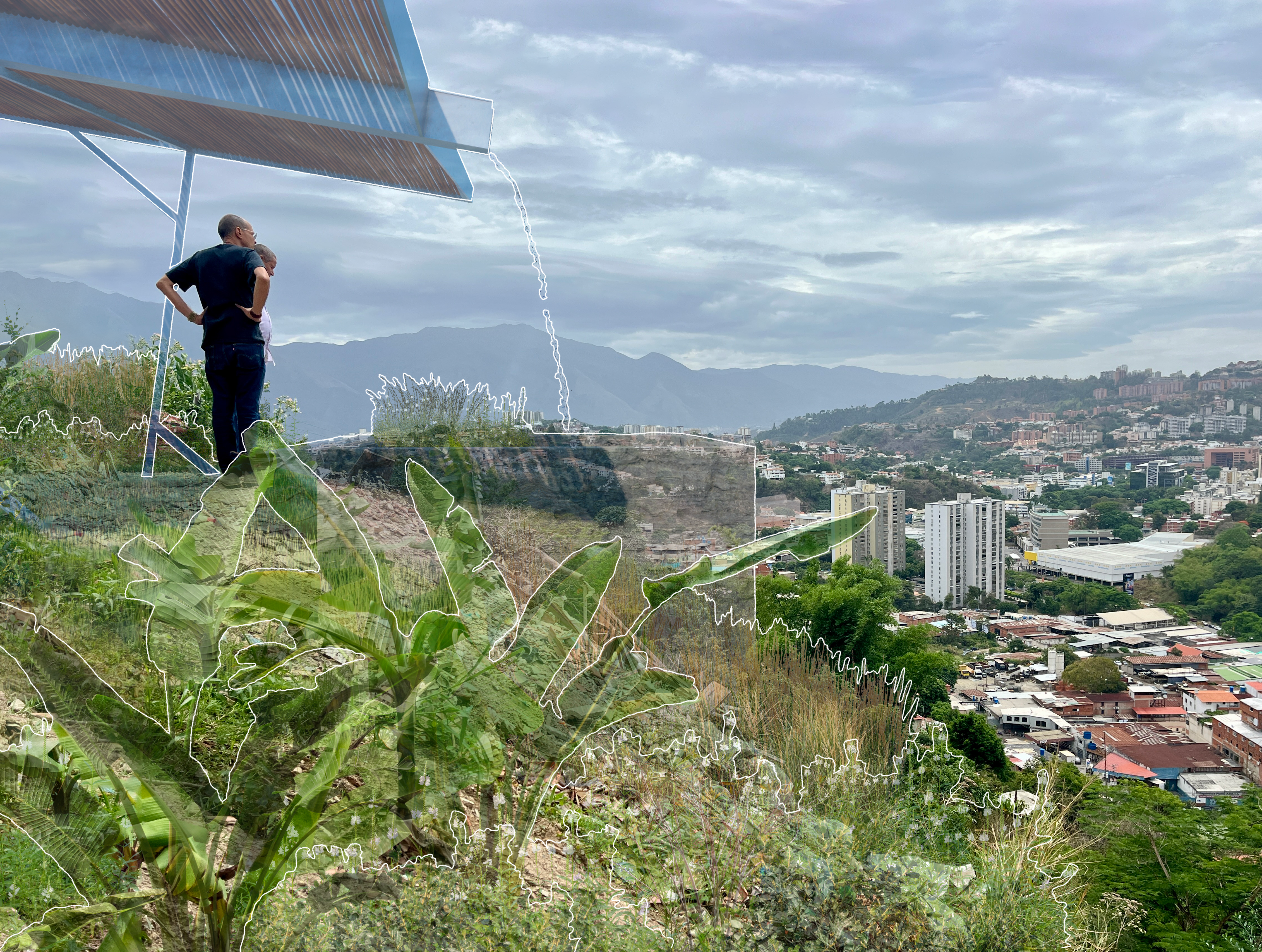
La Palomera Bosque Barrio. Enlace Arquitectura. Caracas, Venezuela.
Cortesía: re:arc institute Practice Lab
Designation: Selecting architecture practices for community-based projects. + The task: commissions not awards + Replicability of the model?
AHG: Another question that comes to my mind is regarding the selection of the practices and the accountability of the whole process. How do you choose and evaluate the different practices? How do you perceive the difference between an award and a grant?
NB: We work both with locally rooted independent researchers and established cultural organisations across various geographies of focus in order to curate and shortlist practices whose work is representative of the contextual, site-specific and community-led approaches we wish to support. For each annual funding cycle, we select 10-12 practices whose portfolio of existing built work features examples of projects and processes making a positive social and ecological impact on their immediate context, blurring the line between which is which. Additionally, we actively seek out examples of their community engagement and participatory design experience, past collaborations with relevant local organisations and NGOs, and proven ability to share and disseminate knowledge through the production of open-source materials and public advocacy.
To me at least this is very different from an “award”. My own sense is that, paradoxically, when architectural awards are bestowed they often tend to do more for the organisation handing out the award than for the recipient in question: prestige and cultural clout have perhaps been exchanged hopefully in both directions, but honestly the underlying power dynamics remain unchanged. In our case, we try to work with situated practitioners who perhaps haven’t managed to parachute “starchitecture” around the world (and perhaps haven’t yet managed to get “awarded” for it…), but whose continued involvement in their own context has led to a unique understanding of the local conditions and opportunities of a potential project, as well as the trust and lasting relationship with their local extended communities to make it happen. I would even actually qualify this process differently to a traditional “grant” — in which the practice is its own stakeholder working on their “dream project”— as I see it closer to a “commission”, albeit for in very different kind of “client” relationship centered around their local stakeholder rather than the funder.
AHG: Do you think this model could be replicated by other philanthropists? What are your concerns on the evolution of the Practice Lab?
NB: Replicability not only of the projects but also of the funding model in itself has always been a very explicit goal and ambition of ours. We are working on what we call the “blueprinting” of this process, with the hope of demonstrating both the “what” and “how” to other non-profit foundations potentially working at the intersection of architecture and climate action. In particular, we are interested in demonstrating the actual “impact” of such a way of working in the non-profit sector. It’s not a secret that the architecture industry is famously terrible at communicating its long-term impact, partly due to the timescales in which buildings operate and evolve but also due to the barrier of entry we often maintain ourselves, which is why it’s also been easier for the non-profit initiatives in our field to double-down on awards and cultural production which totes its own type of “engagement” impact metrics, typically though social media eyeball fracking. There is surely value in this, but there is also value in exploring different ways of activating resources for the built environment, and prototyping different metrics within broader alliances.
Patterns: Similarities and differences across practices and outputs.
AHG: As you are running the first cycles, maybe it’s too soon to be sure but do you see a common way of doing projects between all these firms? Have you discovered some more frequent typologies than others?
NB: Yes, there are at least two patterns. For one, I think there is a methodological pattern in the ways of working and communication in which practitioners have engaged their local communities — their “actual” clients and interlocutors so to speak. The projects that have resulted from this dialogue have enabled a very different type of “authorship”, highly contextual and communal rather than atomised at the scale of one individual in particular. This was refreshing in itself. Another pattern, which may answer your question, has been the emergence of a distinct typology of projects slowly coming into focus at the contours of all 30+ proposals we are currently realising. Given the sample size, we haven’t nor do we necessarily want or need to coin a name for this typology just yet, but I sometimes refer to it internally as “hybrid infrastructures” given the projects’ dual and nurtured ambiguity between social and ecological impact in their given context.
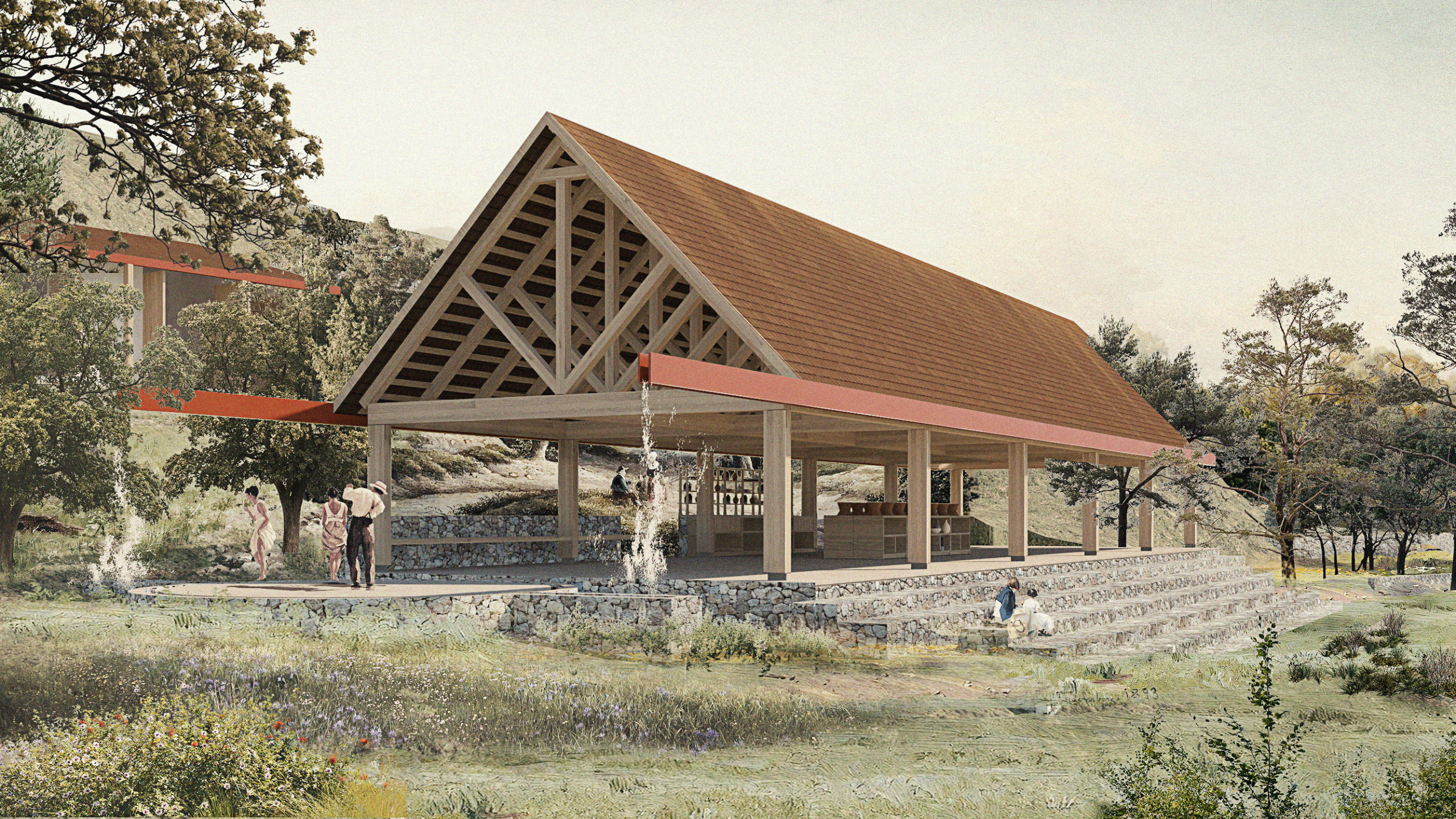
Water Intelligence Hub. ORU | Oficina de Resiliencia Urbana. Oaxaca, México.
Cortesía: re:arc institute Practice Lab
Impact and scale: Scaling impact through multiple small interventions.
AHG: Going back to the part of the scale of the ideas, the scale for this change in the way we consider the profession has to be huge. How do you plan to face that challenge? Should you increase your team?
NB: The institute itself currently consists of a relatively small team of 12 people or so, whereas our little lab consists of only 4 people collaborating across 3 different time zones: our projects lead Olga, our operations coordinator Anita, our research coordinator Betina, and myself. I’m personally comfortable with the size of the institution and am extremely grateful for the daily dedication and diligence of everyone at re:arc! I don’t necessarily think we need to increase the size of the team. And there are also different ways of thinking about “scale”. The most common way is to think of it in terms of growth, but I prefer to think of it in terms of multiplication. This is very relevant both for us but also for any project with ambitions of “planetary” impact, which is sometimes misunderstood as meaning one really big action across the entire globe or one really big “solution” for everyone in the world. But the word “planetary” doesn’t actually mean large scale; it means across scales, both spatial and temporal. From the atomic to the atmospheric, it means multiple scales working together in recursion. In this sense, we hope to achieve planetary impact through the multiplication of several site-specific interventions working recursively together towards something bigger than the sum of their parts. As such we hope to scale re:arc’s efforts through working in parallel with diverse actors and partners living up to the cultural, geographic and disciplinary diversity we’re aiming towards the same goals.
Education: Alternative institutional models for philanthropy in architecture.
AHG: One of your backgrounds is education, both academic and non-academic. Do you see the Practice Lab as a parallel to normal education? Or it’s needed to go further in that effort and build another way of teaching this system of doing?
NB: In many ways, I think I was very lucky in my own atypical educational trajectory. Originally interested in organic chemistry of all things, I attended a well-ranked although fairly conservative engineering-centric Canadian architecture school in the late 2000s, which at the time at least was socialising us into the profession through a diet of sanding intricate balsa wood models, freehand sketching on yellow tracing paper (the “yellow” was important), and a weekly dose perhaps of Viollet-le-Duc or Ruskin over anything remotely related to the conversation we’re having now… While this was a noble attempt at preserving a romantic vision for an otherwise fleeting sense of professional identity, dignity and self-importance during the financial crisis, even back then in my early twenties I felt that this wasn’t a viable framework to navigate with the so-called “real” design forces and parameters that actually shape the built environment with any real agency. In my late twenties, after a few years in corporate professional practice, I tried to remedy this by upending my career and moving all the way to Moscow to join the now defunct Strelka Institute for Media Architecture and Design, where Rem Koolhaas and AMO had famously laid the foundations for an alternative pedagogical model predicated on research and the disenchantment with traditional heroic narratives of architecture. Starting from a researcher, then a faculty and eventually co-director, I was very fortunate to have a role in shaping the curriculum that I wish I had attended as a student, and am very grateful to everyone involved in that institute over my years there.
For me this experience was strangely instrumental to the conception of re:arc institute, where with a larger team of creatives I was invited to contribute to a joint vision for an alternative institution for philanthropy in architecture. As a whole, re:arc institute now both supports and spearheads various pedagogical initiatives indeed parallel to traditional education, and I see the Practice Lab as one more cyclical experiment in “learning by doing” — both meanings of the the word practice, i.e. both making but always making imperfectly — where practitioners can realise meaningful projects and pass on their learnings to the next generation during future cycles.
Cycles: Creative process and sustainability in architecture.
AHG: How do you imagine other offices will react when they learn about it? Will they send emails or apply? Or how do you control this possible vertex or information?
NB: Well we are still a young organisation and haven’t had to deal with an avalanche of solicitations just yet, although a formal “expression of interest” process is something we’re currently working on. To be honest, I find we’ve actually had the opposite problem so far; when reaching out to offices we were interested in collaborating with, many of them were suspicious or skeptical, and some even discarded the invitation as an intricate attempt at spam. “Who calls you out of the blue and asks to give you money for a self-initiated project like that?” Luckily, now in our fourth cycle, we have built a robust community or “cohort” of practitioners that can vouch for the fact that this is real when they get asked…
My hope is that potential lab collaborators see this invitation for what it is: a vote of confidence in continuing to do the work that they already do. An opportunity to mobilise their professional expertise and existing local knowledge and networks in the service of their immediate social and ecological context. Basically, a commitment to identify unaddressed challenges in their communities and apply their know-how on a meaningful co-created brief.
AHG: How to find the offices is the main question.
NB: Working together with my close collaborator and former Strelka Institute colleague Olga Tenisheva, we’ve repurposed the design-research approach of that former institution to discover relevant researchers and organisations who help us build up a rolodex of potential grantees in response to tailored geographies and open-briefs. This effort has resulted in a very vibrant community of young people dedicated to applying their thinking in identifying potential partners and following the projects throughout the process, something which I think is of tremendous value in itself. For each new cycle we also crowdsource suggestions from our former Practice Lab collaborators, who are truly in the best position to recommend future co-conspirators in this collective experiment.
I should also mention that we have openly shared the outcomes of our ongoing research in a public online directory developed and maintained in collaboration with Non-Extractive Architecture. This has been a great way to share our findings with a broader community, and create a platform where future offices can recognise our mission as analogous to their own, self-identify as a potentially relevant fits, and ask to be included to the ongoing directory. This has been another way of testing potential configurations for two-sided dialogue while avoiding the usually highly laborious, stressful and uncertain “open-call” dynamics which sink countless hours of unpaid labor from practices whose efforts would be better spent otherwise. I’m speaking here again from personal experience.
AHG: Talking about these cycles, how do they work, and what results do you expect from them?
NB: Twice a year, we select 8-10 practices and commission them to work on a project proposal together with a local community partner over 3-4 months, which they present to us and our advisory committee through a short executive summary, presentation and 3-5 minutes context video at the end of the proposal phase. Moving into the realisation phase, practices receive a budget up to 250,000.00 EUR to build the project, which the community will subsequently own and maintain. We are currently working with over 30 practices in over 20 countries at various stages in this process, with 22 of them currently in construction.
Proposal cycles are deliberately short, without the expectation to submit a fully resolved architectural project. The objective is to effectively communicate a context, concept, community and afterlife strategy. Something that I have learned during my years in education, and in which I am still a firm believer, is that project concepts are strangely often much better after a six weeks rather than a six months sprint. After a while, you start second-guessing yourself to the point of paralysis given the need for more input, or worse, you assume you’ve resolved every aspect of the “solution” you’re pitching despite the superficially short amount of time allocated. Six weeks is a good amount of time to commit to an opportunity for exploration which, if the proposal gets approved because it truly aligns with re:arc institute’s mission and the actual needs of the community, practitioners will have up to 2 years to develop, resolve and realise in collaboration with them.
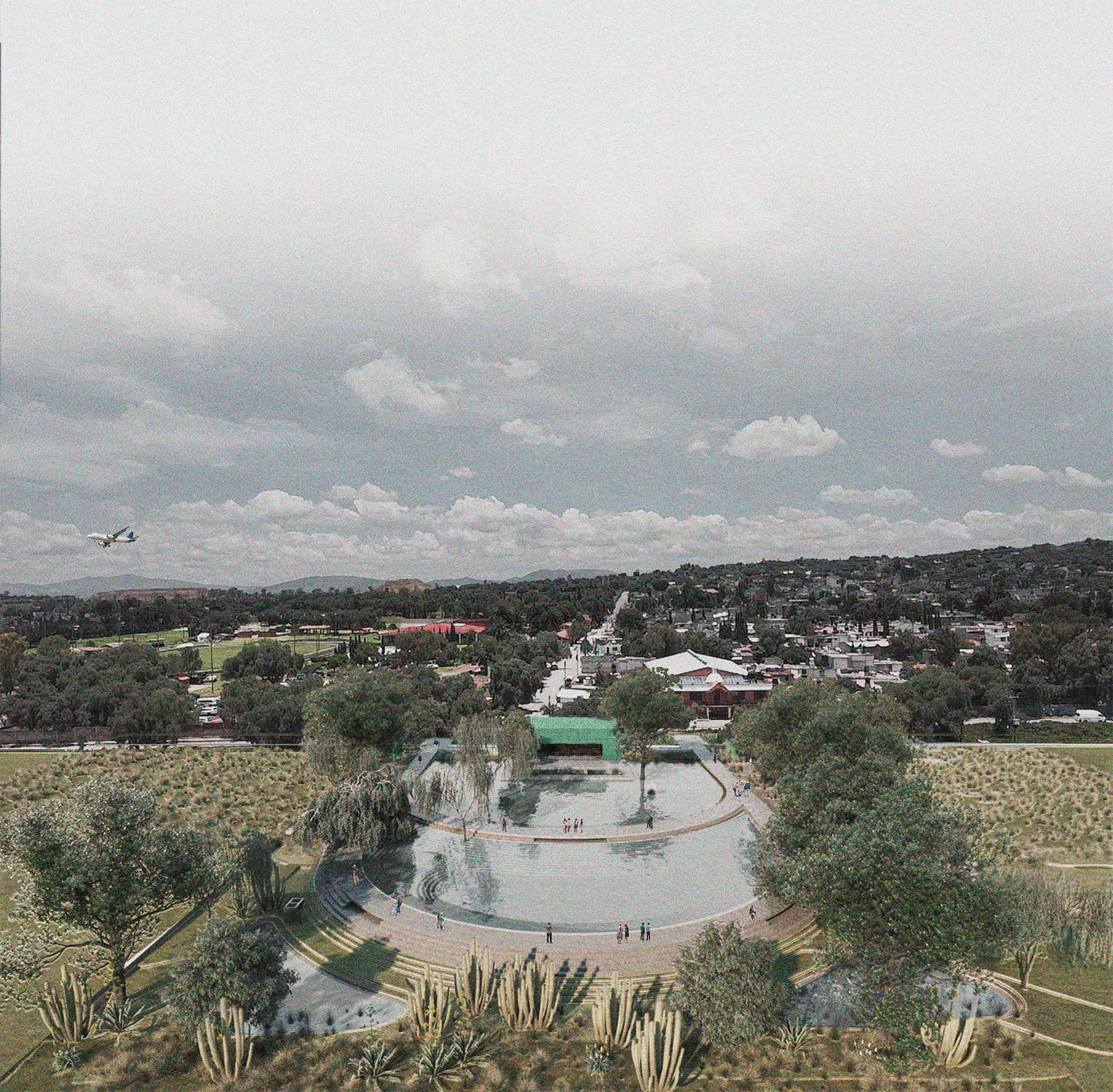
Pooling Xoloc, Taller Capital, San Lucas Xoloc, México. Cortesía: re:arc institute Practice Lab
Afterwards: Designing buildings with community partnerships in mind.
AHG: Regarding the ecological but also economic sustainability of the product, how long are you going to be watching the building after its construction, and in what terms? In Mexico for example we have a complete oblivion regarding public buildings but also on the other side, we have the neoliberal ghost of privatization. So how do you conceive the functioning of buildings and their sustainability and for how long?
NB: Frankly speaking, this is one of the main challenges our experiment hopes to address, as in this alternative funding process the “afterlife” of the projects has been the most difficult to outline from a legal perspective: who will own the project? Who will be responsible to maintain it? How?
Since we are deliberately decentering ourselves as the client, we pay very close attention to the suggested ownership and maintenance strategies of each proposal, because we don’t want to create a burden for the communities in case there was no basis or actual need for the project in the first place. This is partly why it is so important for practices to work closely with a very specific community of users from the start; yes to accurately identify the core purpose and program of the proposal, but also to layer an ongoing sense of caring involvement, responsibility and custodianship for the resulting outcome. I see the practice as contributing to bringing forth not only a built structure, but also an ongoing relationship between a site and its social context, arguably architecture’s actual end product regardless of whether it’s consciously acknowledged or not by the designer. And as this relationship will outlast most architects’ contribution, it is taken into account by us early in the process. Concretely, this means that each project’s realisation is contingent on finding a formal or informal public or institutional body able to contractually take on the responsibility of its afterlife under the terms of the proposal, something which happens in a variety of ways depending on the project. ]
Something that has also been very interesting for us in this atypical process are the alternative institutional constellation of relationships and arrangements that have started to emerge. We see public bodies taking on roles or functions that they wouldn’t have otherwise due to all sorts of political reasons or priorities, or secondary external non-profits stepping in to program and support spaces that they never would have been able to build due to the traditional constraints on philanthropy in architecture that as I’ve mentioned we are working to change. For me this complementarity is an extremely fascinating outcome in itself that will warrant more attention as this experiment continues.
The formula: Architecture, philanthropy, and climate change.
AHG: It’s interesting because, in a way, you’re using the philanthropy project as a way of dismantling the classical idea of the patronage from the king or the prince who is your owner who wants to build a cathedral, to the corporate corporation that wants to do to build a building, to the nonprofit that wants you to build hybrid infrastructures. Could it be a real change in the way that buildings are built by a diverse group of stakeholders?
NB: Buildings have perhaps always been built by very diverse group of patrons, but in our current professional imaginary I sometimes feel that we are stuck in a reductive false dichotomy of “public vs. private”, “state vs. market” and so on which has genuinely limited our ability to conceive and actually design viable contemporary alternatives. As mentioned, I strongly reject the idea of philanthropy as charity and therefore of labelling the architecture that we are trying to enable as “humanitarian” or “social” or “sustainable” in any way that conveniently brackets it away from the rest of architecture. For me, it’s architecture full stop, not a lesser form of something else. My point is that architectural design begins well before the design of the building: it’s preceded by the design of relationships that allow buildings to emerge one way or another, which is preceded by the formal or contractual obligations that have been designed to enable these relationships to actually take place, which in turn is preceded by the institutional frameworks that enable and enforce these obligations… If we start from the other direction, I believe that we can design institutions, which can design formal mechanisms, which can enable and support the actual informal relationships which can give rise to these “hybrid infrastructures” or whatever name we apply for this typology of work that we wish to enable. Another way of saying this: as patronage structures are in themselves design outcomes, it is not enough to keep trying to design alternative “dominos” – we need to design alternative “domino chains” which enable both the dominos we have and the dominos to come to fall in more desirable and viable patterns.
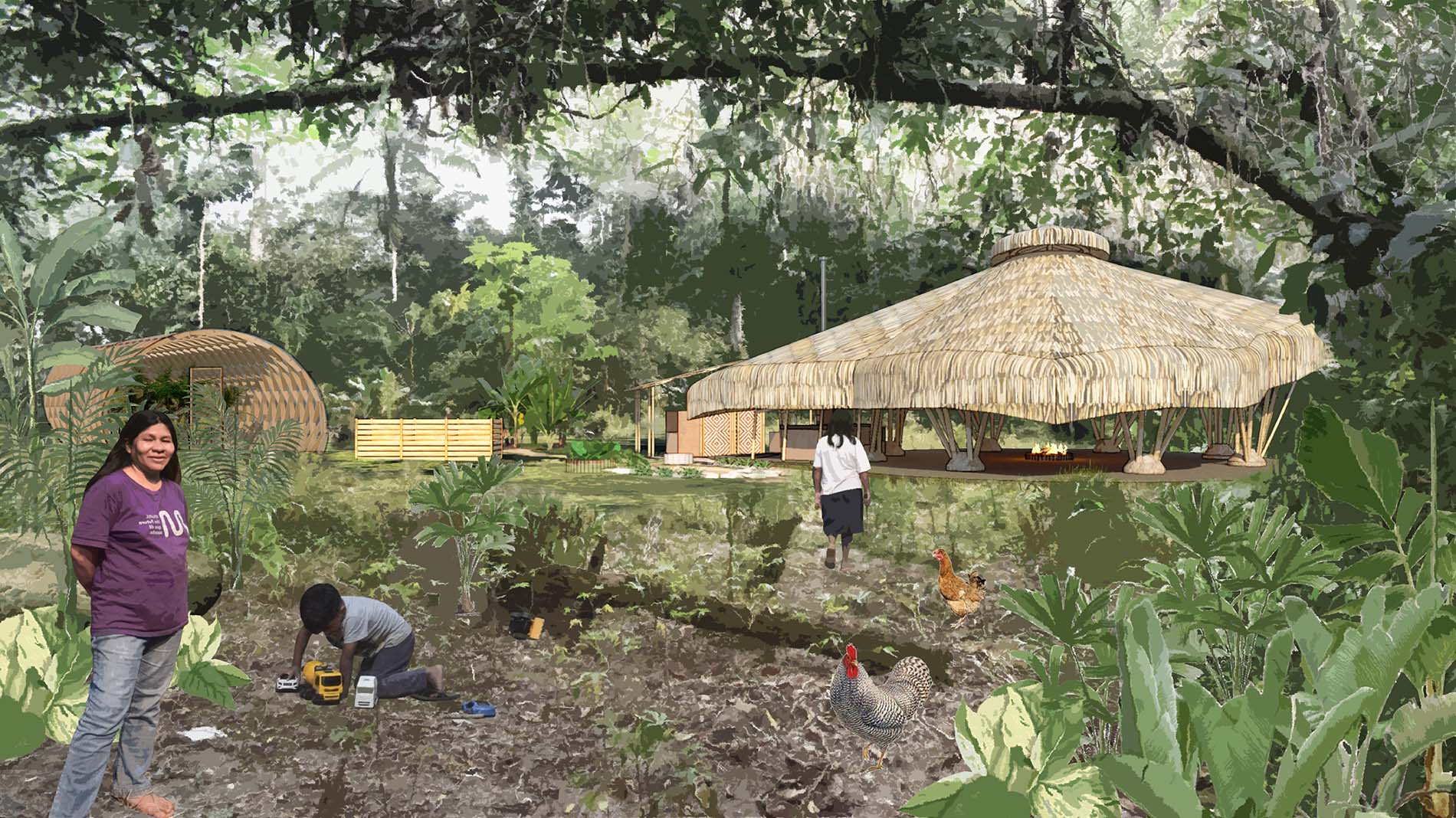
UYRÁ Community Center, Sem Muros. Ubatuba, Brasil. Cortesía: re:arc institute Practice Lab
Expiration date: Climate change and architectural design.
AHG: Getting a bit pessimistic, John Turner, Oscar Hagerman, and other authors that today are eighty years old or more, told similar things back in the 60s and 70s and we let them go like a marginal thing to other predominant discourses. Now we are interested in those discourses. Do you think that the urgency of climate change will make this time to open our eyes or you might become the Lucien Kroll of the 2060’s?
NB: Well I’m from Bulgaria, which is famously recognised amongst the most pessimistic countries in the world… but I am not a doomer. I don’t doubt that by hook or by crook we will eventually transition to something else, an alternative social and economic paradigm more suited for the long-term viability of our survival on this planet from the standpoint of our “species”. But what actually matters are the terms of that transition for the many, a category I would extend past our own species as well.
The terms of that transition are not certain at all. For me, a key lesson from the baby-boomer radicalism of the 60s-70s is the urgent necessity to part ways with its nostalgic impulses for utopia vs. dystopia, good vs. evil, or other binary morally-derived frameworks applied to ecological design. I share your admiration for the work of Lucien Kroll for example, but I truly don’t think that his concept of “incrementalism” is a sufficient framework we can champion or advocate for in good faith given the scope of our contemporary planetary predicament. One “optimistic” hope that I allow myself is that by the 2060s – and this probably more due to necessity than anything else – our society will have finally caught up to or come to terms with the scientific planetary disclosures of the 1960s in terms of our role, impact, and limited albeit extremely real and material design agency on the ecological systems within which we’re contained. This in turn should have finally changed how we think about architecture, site-specificity, social and ecological justice, and all the other important topics we’re touching upon.
Phantoms of the past: The quest and building of normality.
Pablo Goldin: The Kyoto Protocol was already more than 30 years ago and not much has changed. I see in the work of the institute a constant effort to normalize what today seems strange and translate it into pedagogic and professional pathways to follow. My one and last question would be how you imagine you can continue into this “normalization” of architecture and design to face climate change and become something structural?
NB: I don’t know if I have a satisfying answer for this; in many respects, this process of “normalization” is an uphill battle on all fronts, especially since we seemingly continuously even condition ourselves to overuse and overvalue words like “radical”, “revolutionary”, “rebellious” etc. as part of a default rhetorical strategy, particularly in the design and cultural production fields. You can sense that I am critical of this declarative approach but this is mainly from a pragmatic standpoint, as I think that the project of an alternative “common sense” in architecture is far more difficult and impactful than the short-term dopamine effects of potemkin radicality or any false self-narrative of exceptionalism. With that in mind, one way I can imagine this normalization could take place is through the silent, diligent articulation and reaffirmation of different “norms” within the industry, brought about by different agents and organisations that collide with it from different directions as is our case with the Practice Lab through philanthropy. Architecture, for better or worse, is a risk-averse profession and a discipline based on precedents. Its catch-22 is that for something to exist, it has to have existed, so you can point at it. In our work, we hope to create and display realised case-studies that not only have a direct impact on their immediate surroundings and for their immediate communities, but in aggregate also prove the value of these new norms for spatial production through their very presence which you can point to and which speaks for itself, possibly more effectively than any radical manifesto ever could.
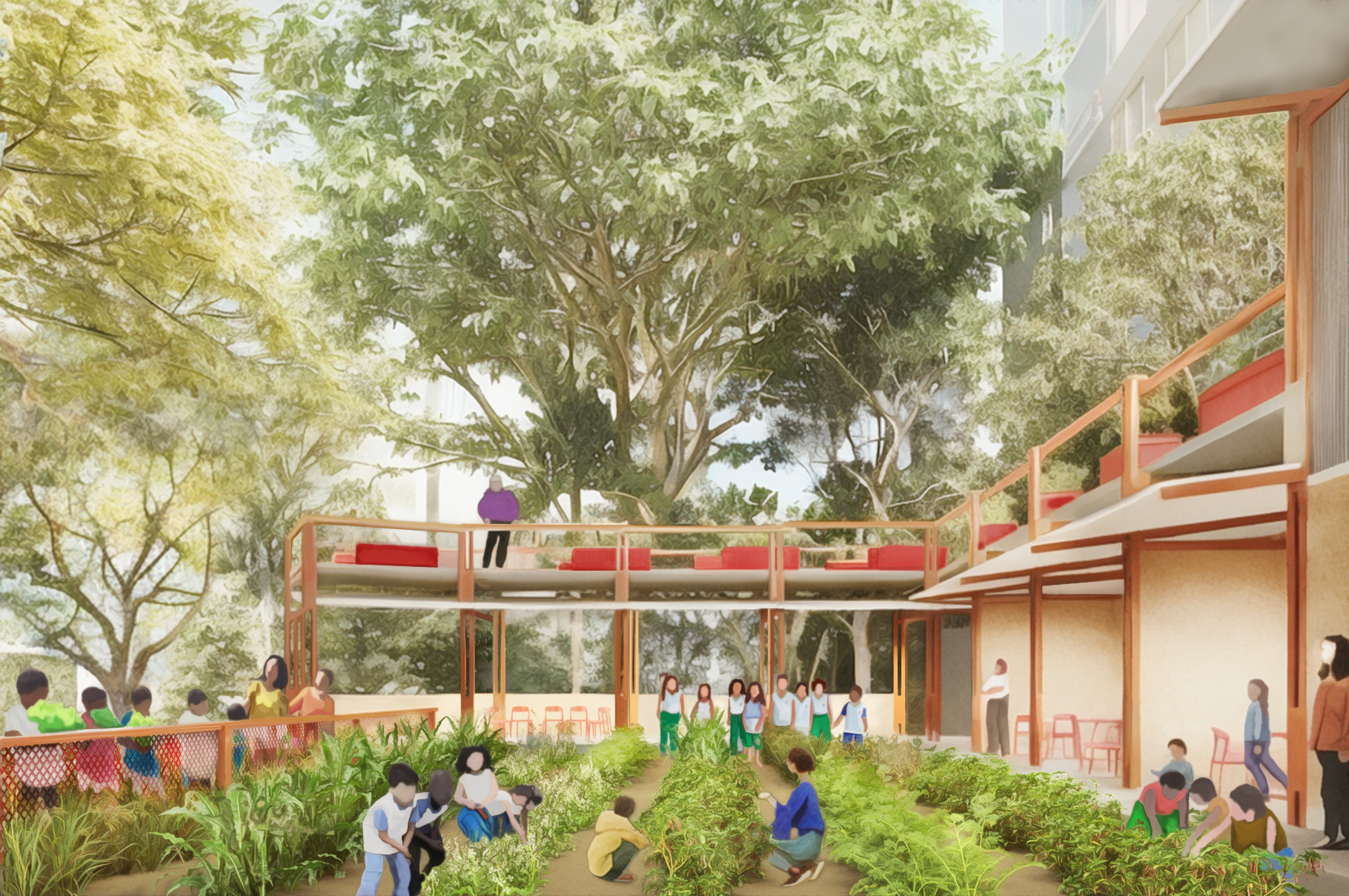
Eco-Social Oasis 9 de Julho. RUINA. São Paulo, Brasil Cortesía: re:arc institute Practice Lab
En el marco de su más reciente exposición en el Museo Franz Mayer de la Ciudad de México, Enrique Norten [...]
Un gobierno situado, un gobierno en el que quienes gobiernan se sitúan, que abierta y explícitamente declaran su posición y [...]